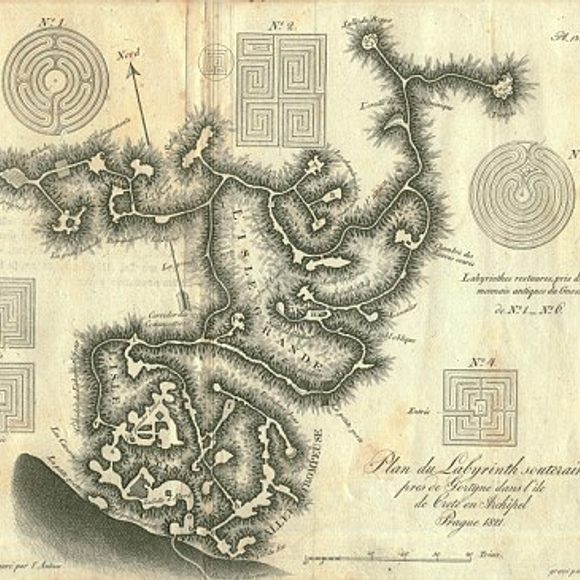Explore the Enigmatic World of Crete’s Labyrinths
Crete, the largest of the Greek islands, is not only renowned for its stunning landscapes and rich history but also for the perplexing labyrinths that dot its ancient terrain. These intricate structures have captivated the imagination of historians, archaeologists, and enthusiasts for centuries. In this article, we will embark on a journey to unravel the mysteries surrounding the labyrinths of Crete, delving into their history, purpose, and the fascinating stories that shroud them in an air of enigma.
A Historical Odyssey: Tracing the Origins of Cretan Labyrinths
The roots of Cretan labyrinths can be traced back to the Minoan civilization, which thrived on the island from approximately 3000 BCE to 1100 BCE. At the heart of this ancient civilization lies the legendary King Minos, associated with the famous labyrinth in Greek mythology that housed the Minotaur. While the mythological aspect adds an aura of fantasy, archaeological evidence suggests the existence of intricate structures on Crete resembling labyrinths.
The most iconic labyrinth is believed to be the one at Knossos, a Minoan palace near Heraklion. Discovered by Sir Arthur Evans in the early 20th century, the labyrinthine layout of Knossos has sparked numerous debates about its purpose, from serving as a ceremonial space to functioning as a symbol of Minoan spirituality.
Deciphering the Design: Unraveling the Structure of Cretan Labyrinths
The labyrinthine design of these structures is a distinctive feature that sets them apart. Characterized by a complex network of interconnected paths, these mazes often lead to a central point, creating a sense of intrigue and confusion. The symbolic significance of the labyrinth in Minoan culture is still a subject of scholarly speculation.
Archaeologists have identified different types of labyrinths on Crete, ranging from simple patterns etched into pottery to more elaborate designs in architectural contexts. The spiral motifs found in many Cretan labyrinths suggest a connection to ancient rituals and beliefs, emphasizing the spiritual and symbolic dimensions of these mysterious structures.
Labyrinth or Maze: Understanding the Terminology
The terms “labyrinth” and “maze” are often used interchangeably, but there are subtle differences between the two. A labyrinth typically has a single, non-branching path leading to the center, creating a meditative and contemplative experience. On the other hand, a maze is a complex network of branching paths with dead ends, designed to challenge and confuse those navigating through it.
The Cretan labyrinths, with their intricate yet purposeful designs, exhibit characteristics of both labyrinths and mazes. The intentional layout, coupled with the spiritual undertones, suggests a deeper purpose beyond mere navigation.
Unlocking the Mysteries: Theories Surrounding Cretan Labyrinths
Numerous theories abound regarding the function and significance of Cretan labyrinths. Some scholars propose that these structures served as ceremonial spaces for religious rituals, while others suggest they played a role in the mystical initiation rites of the Minoan civilization. The absence of concrete evidence and the enigmatic nature of Minoan writing systems add layers of complexity to unraveling the true purpose of these labyrinths.
One intriguing theory is that the labyrinth at Knossos, in particular, may have been a representation of the Minoan cosmogram—a symbolic map of the universe. This cosmic interpretation aligns with the Minoan fascination with the natural world and celestial bodies, providing a unique perspective on the labyrinth’s significance.
FAQs: Navigating the Labyrinth of Questions
Q1: Were Cretan labyrinths designed for practical purposes or purely symbolic? While the exact purpose remains uncertain, evidence suggests a combination of both. The intricate designs and spiritual motifs point to symbolic significance, while the architectural contexts hint at practical applications, possibly serving as ceremonial spaces or reflecting the Minoans’ understanding of the cosmos.
Q2: Did all Minoan palaces on Crete have labyrinths? Not all Minoan palaces featured labyrinths. The most famous example is the labyrinth at Knossos, discovered by Sir Arthur Evans. While labyrinthine motifs appear in various forms across Minoan artifacts, the specific use and prevalence of labyrinths varied.
Q3: How do Cretan labyrinths contribute to our understanding of Minoan culture? Cretan labyrinths provide valuable insights into the spiritual and symbolic aspects of Minoan culture. They reflect the Minoans’ intricate worldview, their connection to the natural world, and the mysteries surrounding their religious and ceremonial practices.
In conclusion, the labyrinths of Crete continue to be a source of fascination, inviting us to explore the depths of ancient mysteries. While the true purpose remains elusive, the enigmatic designs and symbolic motifs of these structures offer a captivating glimpse into the rich tapestry of Minoan civilization. As we navigate the twists and turns of history, the labyrinths of Crete stand as silent witnesses to a bygone era, leaving us to ponder the secrets they hold.

